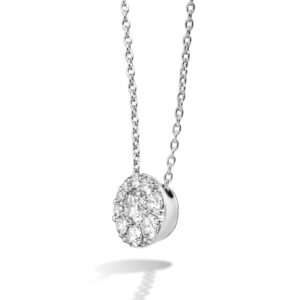The Diamond, April’s dazzling birthstone, is by far one of the best-known and arguably most sought after throughout history. Although diamonds have been considered the ultimate symbol of eternal love for centuries, it’s surprising how little the average person actually knows about them.
Diamonds have played a number of roles throughout history. They have been considered splinters of fallen stars, presumed to be the tears of God, hold mystical powers and even serve as a healing agent; but most importantly, diamonds are April’s birthstone!
Here are a few surprising facts you may not know about the king of all birthstones:
-

Diamond color is based on a number of impurities: Brown diamonds get their color from lattice defects, green diamonds have been exposed to radiation, blue diamonds have traces of boron and yellow diamonds have traces of nitrogen.
- Diamonds are fireproof: To burn or melt a diamond it must be heated to 1292 degrees fahrenheit, that’s pretty hot!
- Diamond literally means indestructible: The word Diamond originated from the Greek word adamas—meaning unbreakable, unconquerable and indestructible.
- Diamonds are composed of a single element: Diamonds are a mineral compound made up of pure carbon.
- Diamonds really are forever: It’s true! Due to their extremely rigid crystalline structure, diamonds are the hardest substance found on earth—they’re virtually indestructible! This rigid structure is due to the unique way carbon particles bond within a diamond when put in the extreme conditions found below the earth’s surface. To learn more about the structure of a diamond, check out our blog on the Anatomy of a Diamond.
- Diamonds date back billions of years: While the Earth is estimated to be approximately 4.5 billion years old, the oldest diamond is believed to be about 3.3 billion years old—most diamonds found in nature are between one to three billion years old!
- Diamonds come to the surface through volcanic eruptions: Diamonds are the product of immense pressure and intense heat, formed over 100 miles below the earth’s surface. The longer a diamond lies below the earth’s surface, the larger it grows. Overtime, diamonds are carried to the surface (inside rocks) by volcanic eruptions!
- Meteor strikes can create diamonds: There are only two places on earth that can produce diamonds—below the earth’s crust and at the site of a meteor strike. Although not all, or even the majority of diamonds found on earth come from meteors, a particular type of diamond called Carbonado (found primarily in Africa and South America) is believed to be the result of an asteroid hitting earth over three billion years ago.
- Only 20% of diamonds are suitable for jewelry: Many think of diamonds as the beautiful engagement ring centerpieces we all know and love—however only 20% of the diamonds mined around the world are used in jewelry! The other 80% are used for industrial purposes.
- The largest diamond wasn’t found on Earth: The largest diamond ever discovered is actually a 10 billion trillion trillion carat white dwarf star named Lucy.
- Diamonds were once considered a judge of innocence or guilt: At one point in time, Jewish High Priests used diamonds to judge guilt or innocence by holding a diamond in front of a person convicted of a crime. They believed that the more truthful someone was, the more diamond would sparkle when placed before them. However, the same diamond would theoretically dull or darken if the person was guilty.
- Diamonds Have Been Outlawed in the Past: In 13th Century-France there was a law decreed that only the King was allowed to wear diamonds.
- Diamonds Engagement Rings Have Been a Tradition Since 1477: The first diamond engagement ring is given to Mary of Burgundy by the Archduke Maximilian of Austria, beginning the tradition of a man proposing to his intended with a diamond ring.
Discover April’s Birthstone at Your Trusted Jewelry Store in DC
If you’re looking to celebrate a birthday, anniversary, or simply treat yourself to something timeless, there’s no better place to explore diamonds than at Charles Schwartz & Son, the premier jewelry store in DC. With over a century of experience, we specialize in sourcing, restoring, and showcasing exquisite diamond pieces—each with its own unique history and sparkle.
Whether you’re shopping for an antique diamond engagement ring, a classic pendant, or customizing something truly one-of-a-kind, our experts are here to guide you every step of the way. As Washington’s oldest jeweler, we take pride in helping our clients find pieces that are not only beautiful but meaningful.
If you’re looking to celebrate a birthday, anniversary, or simply treat yourself to something timeless, there’s no better place to explore diamonds than at Charles Schwartz & Son, the premier jewelry store in DC. With over a century of experience, we specialize in sourcing, restoring, and showcasing exquisite diamond pieces—each with its own unique history and sparkle.
Whether you’re shopping for an antique diamond engagement ring, a classic pendant, or customizing something truly one-of-a-kind, our experts are here to guide you every step of the way. As Washington’s oldest jeweler, we take pride in helping our clients find pieces that are not only beautiful but meaningful.
Diamonds are ideal for any April birthday gift! Stop by Charles Schwartz & Son and check out our unique collection of diamond jewelry today!



